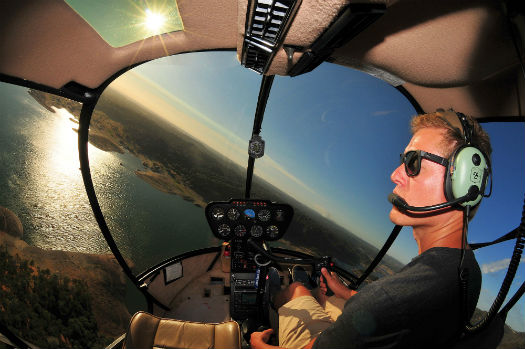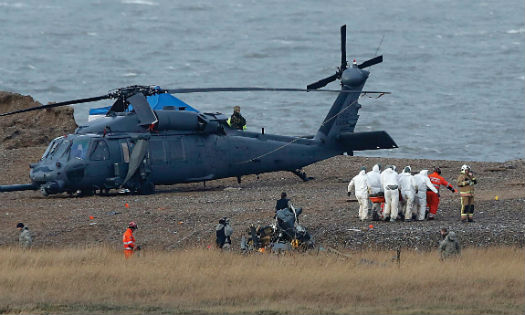
Birds are more commonly found at lower altitudes — anything up to 2,000 feet above ground level is still considered to be within the “bird zone.” Skip Robinson Photo
In January 2014, a fatal accident claimed the lives of four U.S. airmen flying a training mission from their base at RAF Lakenheath in the U.K., and returned international focus to the danger of bird strikes in aviation. The crew was beginning a nighttime rescue scenario of a downed F-16 pilot in their Sikorsky HH-60G Pave Hawk, flying at about 110 feet above ground level and 110 knots indicated air speed. Strong winds pushed its flight path over Cley Marshes — a nature reserve popular with bird watchers. As it approached, a flock of geese took flight, likely startled by the noise of the aircraft, and at least three of the birds went through its windscreen, striking both the pilot and co-pilot with such force that both were knocked unconscious. Another goose hit the aircraft’s nose, disabling the trim and flight path stabilization systems, and the aircraft banked to the left, hitting the ground just three seconds after the strike. The impact killed all four on board.
The official accident investigation makes understandably sober reading, particularly when it highlights the force exerted by a strike from such birds, which typically weigh between six and 12 pounds. “A bird weighing 7.5 pounds would impact with 53 times the kinetic energy of a baseball moving at 100 miles per hour,” the report states.
While such catastrophic bird strikes are rare, they’re certainly not unprecedented, and with a recent uptick in the reporting of incidents — whether or not they cause damage — we’re building a more accurate picture than ever before about the size and scope of the danger.
Creating the data
The Federal Aviation Agency (FAA) recognized the need to determine the magnitude of the bird strike problem in the U.S. in 1990. To enable it to do so, it asked pilots to begin reporting all bird strikes, regardless of whether they caused any damage. The official FAA Wildlife Strike Report, which can now be filled out on paper or online, requests information on the aircraft involved, when and where the strike occurred, and even the species of bird/animal struck. If all that is left of a bird or animal is unidentifiable remains, samples can be sent to the Smithsonian Institution’s Feather Identification Lab for forensic ornithologists to identify.
This information led to the creation, in 1995, of a bird strike database, put together by the FAA in conjunction with the U.S. Department of Agriculture Wildlife Services. To interpret the data, the FAA created a serial report called Wildlife Strikes to Civil Aircraft in the United States. First published in 1996, it is updated every year. (Many other countries also request that pilots report any wildlife strikes. North of the border, Transport Canada has a standard form on its website that can be filled out on paper or sent electronically.)
Phyllis R. Miller, a scientific data technician with the USDA Wildlife Services, is one of the “keepers” of the FAA Wildlife Strike Database. She provided Vertical with some numbers to consider. From January 1990 through December 2014, there were 1,894 reported strikes on helicopters. The breakdown by decade looks like this: from 1990 to 1999, there were 215 strikes; from 2000 to 2009, 514 strikes; and in the five years between 2010 and 2014, there were 1,165 strikes. Most of the experts in the area seem to agree that the bird strike problem isn’t simply getting that much worse; rather, pilots are reporting strikes more diligently.
Of the 1,894 reported strikes, 523 (or nearly 28 percent) produced damage. Again, these numbers are probably slightly weighted, with damaging strikes more likely to be reported than those that did no damage. In 2014, there were 231 wildlife strikes on helicopters with 32 (14 percent) producing damage and nine (four percent) of those being substantial damage. (As defined by the International Civil Aviation Organization, “substantial” damage is when an aircraft incurs damage or structural failure adversely affects its structural integrity, performance, or flight characteristics. It normally requires major repairs or the replacement of the affected component.)
For the military, the numbers are even greater. A recent study of the four branches of U.S. armed services noted 2,500 strikes from 1990 to 2011. Of the total strikes, 362 (or over 14 percent) produced at least some damage.
The eagle-eyed among you will have noticed that these incidents are officially called “wildlife strikes” — not just bird strikes. Although birds make up the vast majority of such encounters, both helicopters and planes also occasionally encounter bats in flight. However, since they are usually small and do little, if any, damage, bats are not a major concern. For fixed-wing aircraft, terrestrial animals can also become hazards if they wander into the plane’s path on a runway (planes have even been destroyed by collisions with larger animals such as deer). The vertical takeoff capability of helicopters means these land-based creatures pose little threat to rotary-wing pilots.

The crash of a HH-60G Pave Hawk near RAF Lakenheath in the U.K., which killed four U.S. airmen in January 2014, was a stark reminder of the danger presented by bird strikes. AP Photo
The vast majority of bird strikes from smaller birds do little or no damage to helicopters, but, as highlighted in the accident investigation report into the HH-60G Pave Hawk crash in the U.K., the impact from a larger bird can be enormous. In the U.S., raptors, vultures, gulls, and geese account for most of the worst incidents.
The total damage from bird strikes to helicopters is significant. According to Phyllis Miller, the 32 reported helicopter strikes that caused damage in 2014 were responsible for over $350,000 in losses. The repair or replacement cost is only part of the monetary loss for civilian aircraft; down time when the helicopter is out of service for repairs means revenue loss as well.
But monetary loss pales in significance when compared to the very rare bird strikes that cause injuries or fatalities. According to official figures, bird strikes to civil and military helicopters in the U.S. have resulted in 61 injuries and 11 deaths since 1990. Eight of those fatalities occurred in a single accident in January 2009, when a red-tailed hawk smashed the windshield of a Sikorsky S-76C++ that was taking passengers out to an oil rig in the Gulf of Mexico, causing the aircraft to crash into marshy terrain near Morgan City, La. National Transportation Safety Board (NTSB) investigators said the impact of the bird likely jarred the fire extinguisher T-handles out of their detents and moved them aft, pushing both engine control levers into or near the flight idle position, reducing fuel to both engines. “The pilots were probably disoriented from the broken windshield and rushing air and were unable to react in time to maintain control of the helicopter,” stated the NTSB press release that announced its final report. In it, the NTSB was highly critical of the lack of Federal Aviation Administration (FAA) requirements for bird strike-resistant windshields.
Mitigation efforts
For fixed wing aircraft, most bird strikes occur at or near airports when the planes are at lower altitudes. For helicopters, the relatively slower and more vertical take-offs and landings lessen the risk in these areas. For rotary-wing aircraft, the threat is away from the airport. Here, greater forward speeds combined with often a low altitude flying increase the chances of encounters with birds.
With the threat to planes being mainly in and around airports, most of the bird strike mitigation efforts have been concentrated there. Making these areas less attractive to birds, frightening them away, and occasionally even culls have worked to a great extent. While such efforts make these areas safer for helicopters, other techniques need to be employed to help minimize the threat of an encounter with a bird en route.
The Helicopter Safety Advisory Conference has provided several recommended practices for bird strike avoidance to increase flight safety. The first is pilot training in bird avoidance techniques, which it recommends performing on completion of initial training, with re-currency annually.
As for general flying patterns, birds are more commonly found at lower altitudes. Up to 2,000 feet above ground level is still in the “bird zone,” but for every 1,000 feet of altitude a pilot climbs, there is a significant reduction in bird activity.
If you’re flying at lower altitudes, reduce your speed to lessen the strike risk and to give yourself more reaction time to maneuver around any birds.
As one would expect, the front canopy of a helicopter — and the windscreen in particular — is the most likely area to be hit by a bird strike. Typically, the flight integrity of the aircraft is not directly compromised; the concern is the impact on the pilot. The situation immediately becomes critical if the pilot’s sight is affected or he/she is injured or even knocked unconscious. If the pilot or pilots are unharmed, they must be able to quickly regain their composure in order to safety land the aircraft. Remember to report all bird strikes.
What can pilots do to physically protect themselves? Experts on bird strikes recommend that pilots fly using a helmet with the visor down — or with some type of eye protection at least. And, as echoed by the NTSB report on the fatal crash near Morgan City, there are some who are calling for windscreens to be designed to better withstand the impact from a larger bird. There is interest from the original equipment manufacturers in bringing these to market — for example, Bell Helicopter enlisted component manufacturer Texstars to produce a “bird-strike resistant” windshield for the Bell 525 Relentless early in the helicopter’s development. The new windshields are made of polycarbonate as opposed to the older cast acrylic, and this “softer” material should not be prone to shattering.
Knowledge is Power
With bird strikes being a problem along flight routes and actions aimed at the birds being impractical, knowledge of bird whereabouts and activity can be hugely beneficial. Where are we most likely to find birds? Food sources such as farm fields and landfills should be avoided if possible, as should wildlife sanctuaries. Migration routes are fairly well known and should be avoided during those times of the year when birds are en route to a new location. Take a look at the details of wildlife strike events that have taken place in your area of operation to give yourself an idea of any patterns in terms of when and where strikes are more likely to happen.
To help its pilots, the U.S. Air Force developed the United States Avian Hazard Advisory System (AHAS) using Geographic Information System (GIS) technology. The AHAS includes input from the Bird Avoidance Model (BAM), which incorporates data on bird habitat, migration, and breeding characteristics. Real time data from NEXRAD radar sites (which can detect birds) are also added. Pilots can check routes across the continental U.S. and determine the bird strike risk. This service is available online to the general public at www.usahas.com.
Finally, remember that injuries and fatalities due to bird strikes are extremely rare, and seldom is a strike serious enough to inflict significant damage. That said, any time we have the opportunity to reduce the risk of an incident, it’s worth doing so. If you are unfortunate enough to suffer a bird strike, report it. The more information we have, the more likely it’ll be that we can create effective avoidance strategies in the future.






Thanks Ed! This was really helpful for my case analysis on helicopter bird strikes!
What about maneuvering the aircraft to miss birds when they are unexpected, just like you would maneuver your car to miss another car? That seems like the most logical but nobody seems to be talking about it.